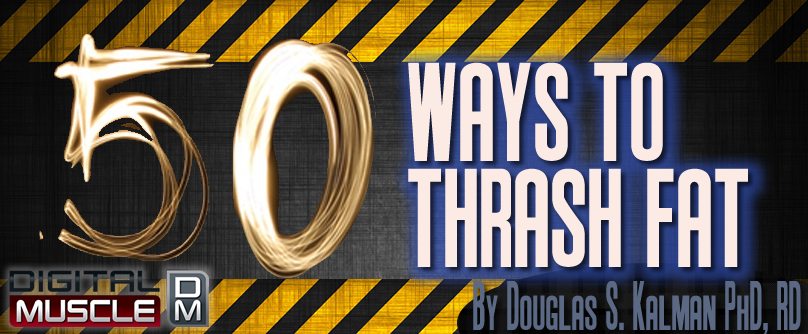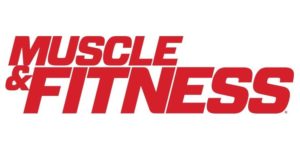By Dr. Doug Kalman, Nutrition Editor
Whether you’re a competitive athlete or you just like the lean look, keeping your body fat in check may help to extend your lifespan. I’ve put together a few tips, 50 to be exact, to help you thrash body fat, and in the process, help you to live life to the fullest!
The Top 50 (in no particular order of importance)
1) Determine how many calories that you need to eat daily to maintain your current body weight. To do this is simple, search the web (Google) and plug in the term “Harris Benedict Equation” (HBE). You will stumble across many sites that ask you your height, weight and age and activity levels. After some quick math, your daily caloric need will be presented to you. Do not eat this number of calories choose 500 less daily. For example, if the HBE indicates you need 4,000 calories, eat 3,500 daily. Use this website: http://www.bmi-calculator.net/bmr-calculator/
2) Make sure that your diet contains at least a ½ gram of protein per pound of body weight (minimally). Protein is more thermogenic than any other macronutrient. Your body expends more energy in the digestion, metabolism and absorption of protein than it does carbohydrates or fat.
3) Any meals that contain simple carbohydrates should also contain at least five grams of fiber (except for your first post-exercise meal or shake). Fiber helps maintain a normal blood sugar (avoiding the high reaction after eating sugars), thus by controlling the insulin response to food you can help control your body fat.
4) Make sure to eat five to six smaller meals daily rather than the typical two or three square meals advocated by your school teachers. Small frequent meals help reduce the overall peaks and valleys of blood sugar/insulin along with helping you to avoid ever feeling ravenous.
5) Make sure to always drink water, ideally before each meal. Many times when you actually think you feel hunger, it is thirst. Most of us do not stay optimally hydrated.
6) It is said that exercising in the morning before eating, especially doing aerobic type exercise helps with fat burning to a greater extent than if you did it (the exercise) later in the day. Reality is, the time of day that you can give maximum effort is the right time of the day for you to train.
7) Optimize your weekly exercise routine to include both weight lifting and aerobic exercise. The more calories burned (as compared to those eaten), the easier fat loss is. Keep in mind that fat burning is different than not eating enough to spare muscle. Over-exercise when coupled with not eating enough is a sure way to not even look like an athlete or a lifter!
8) If having to choose an exercise due to time constraints and wanting to burn the most calories in “x” amount of time, do an aerobic type (i.e. jogging for 30 minutes). Over the short-term you burn more calories by doing aerobics as compared to weight lifting.
9) Make sure to include weight lifting in your weekly workouts – over the long-term, the more muscle tone you have, the more calories that your body burns all day long. Aerobic exercise does not really impart this metabolic benefit.
10) Do not neglect lower body exercises. The king of leg exercises, squats, especially if done in conjunction with other leg exercises can help build muscle everywhere and is a great way to expend extra energy.
11) Change your diet to one that is more of an even distribution of carbohydrate, protein and fat. A study from Arizona State University found that a 40/30/30 diet increased the amount of calories expended after a meal 100% greater than the typical recommended diet of 65/15/30. Thus, it appears that a 40/30/30 diet for those that typically follow a high-carb diet will help more with fat burning.
12) If you have a pet (or even if you don’t) take a 30-minute walk after your last meal of the day. Our metabolism generally is fastest early in the day and wanes as the day progresses, but doing some exercise later in the day, you can spark your metabolism. With a pet or alone, it is a great fat slashing thing to do.
13) Do not eat when you are bored. It sounds simple, but many people gain unwanted weight by munching at night when not actually hungry.
14) Learn to eat when it’s feeding time. Simply put, by planning your meals and the times that you will eat the five or six small meals, you are taking the guesswork out of the body fat control question.
15) If you know you are going to be traveling and cannot bring homemade prepared foods with you, take advantage of ready-to-drink protein shakes and protein-centric bars. The convenience items are super in keeping a diet clean.
16) Do not under-eat by too much. If you consistently eat way too little, your body will start to think it is in a starvation state and for the initial period, weight loss and fat loss may become harder than anticipated. After a while of severe underfeeding instead of preferentially burning fat for energy, muscles – your hard earned muscle will be burned for energy.
17) Make sure that your daily food routine includes five or more servings of vegetables daily. Vegetables are a good source of fiber as well as being power packed with phytochemicals and minerals. Nutritionally, they are a heart disease and cancer defense plan.
18) Keep in mind, if a product or exercise program sounds too good to be true, it probably is. Weight loss products shown on infomercials usually do not work.
19) Your metabolism is the key to weight loss, raising your metabolism will force weight loss to happen very quickly. Thus do things to keep your metabolism optimally activated daily.
20) Keep a diet record. Note what types of foods you eat, what time of the day you are eating them and what mood you are in. Incorporating the use of websites such as Fitday.com to note just how many calories you are eating. Food diaries allow you to explore the mood-food interaction and just how much you really eat.
21) If you use food as a reward, establish a new reward system. Perhaps buy yourself a non-edible reward or treat yourself to a massage.
22) Substitute activity for eating. When the cravings hit, go to the gym if possible; or dust the furniture, pay bills, etc., or walk around the block. This is especially helpful if you eat out of anger.
23) Don’t shop when you’re hungry. You will only shop with your stomach instead of your brain for what you really need. You may also buy more fattening food.
24) If at a party, learn to avoid finger foods that are easy to eat in large amounts. Avoid consuming large quantities of fattening liquids, which are so easy to overdo. And this includes alcoholic beverages.
25) The most common reason people lose interest in exercise / dieting is due to unrealistic goals. Set realistic goals for you to accomplish on a weekly, monthly and quarterly basis.
26) Eat smart and supplement in a wise fashion. Use the www.jissn.com or www.consumerlabs.com to learn more about smart supplementation.
27) Use the power of positive thought. Envision yourself being able to do what you once thought impossible. Positive imagery can elicit a strong brain-body connection allowing you to “get there”.
28) Do not eat in a manner meant to simulate a hot dog eating contest. In other words, eat food slowly. This helps make you feel satisfied sooner, helping to consume less food and calories.
29) Cook meals yourself. Try experimenting with recipes using natural ingredients, herbs and spices – you may be surprised at the difference it can make. Recipes from epicurious.com and other great websites can be a real boon in making your diet scrumptious.
30) Always start the day with a good breakfast this may help stop any cravings between meals and will give you more energy. Since your metabolism is revved the highest in the early part of the day, eat the bigger meals earlier in the day.
31) When choosing buying a drink such as a soft drink choose low calorie ones or unsweetened fruit juices diluted with water. The calories from regular sodas and juices can add up very quickly. One extra soda daily can equate to a 15.5 pound weight gain in one year.
32) Alcohol generally contains 100 to 150 calories per serving – do not go overboard with libations. Factor any planned drinking into your daily goal calorie level.
33) Do not rely on weighing scales to monitor your progress, if body fat reduction is your goal, get yours tested by a qualified health care practitioner.
34) Foods labeled as fat-free often are laden with sugar. Thus, fat-free foods are not to be used as a cornerstone ingredient in any fat-slashing plan.
35) Stay active. But don’t sit too long. The human body is good at adapting. If you dig ditches without gloves, you will develop calluses to protect your hands. If you sit too long, you will develop extra padding to keep you comfortable!
36) If you want to learn how many calories are burned per hour for your activity (exercise or household), see the website http://www.caloriesperhour.com/index_burn.html It’s a great resource.
37) You cannot spot reduce. Anyone that tells you this is either a plastic surgeon (who can help you spot reduce) or is a huckster. There is no one exercise that spot reduces nor diet that enables this as well.
38) Include interval training in your routine. Interval training is a great way of improving your cardiovascular fitness and slashing body fat. See http://www.mensfitness.com/training/cardio/8-amazing-fat-burning-intervals to learn more about this method of alternative training. Just once or twice per week is all you need.
39) Include whole grains in your diet. One such low-glycemic carbohydrate is the barley.
40) Don’t skimp on weight training. Every extra pound of muscle will burn an additional 30-50 calories, even at rest!
41) Have a treat once per week. Being too stringent on a diet can begat a downfall. To prevent this, once per week for one meal have your favorite foods. This may also cure cravings for foods that you are avoiding.
42) Find a fat loss “buddy”. This will help you stay with your weight loss program. Having support is a great way to stay motivated.
43) Read food labels. Foods with a high percentage of fat – more than 50% (or carbohydrates that are sugars) will slow down your weight loss program. Do not just count grams, but instead note the percentage of total calories that are fat or sugars. You can track your caloric intake here: http://www.caloriecount.com
44) Chart or graph your weight loss and serving selections. This will allow you to note your progress and changes that you are making in your life.
45) Change your exercise routine every few weeks. As your body adapts to exercise it becomes harder to achieve the change that you seek – thus by changing your exercise routine you are always keeping your body on alert, avoiding stagnation.
46) Have yearly blood tests – make sure, as you would with your car, that your body internally is in A-1 working condition. Do not avoid physicals.
47) Ask your health care practitioner about which dietary supplements in addition to the daily multivitamin will be best for slashing fat and aiding in body fat reduction. Look for supplements that have undergone clinical research demonstrating that they work and are safe in the manner they were tested.
48) Do not be afraid of dietary fat. Choosing the right types of fat (olive oil for example) and sources of fats (nuts, salmon, etc.) can be the difference in your metabolic spark. Coach John Berardi PhD, CSCS of Canada encourages the combination of protein and fat in all meals except for the post workout meal that should be protein and carbohydrate.
49) Be “inefficient” in your daily activities- do you need to go to the kitchen to get a couple of things? Break it up into to two trips even if you can do it in one. Being inefficient like this can easily double your activity level, burning calories without even trying.
50) Don’t let yourself get hungry – when you get hungry you will have a greater tendency to overeat when you do finally get something to eat. As well, because your body is starting to go into starvation mode, it will be much more likely to hold onto whatever you give it.
Those are just a few suggestions, 50 of them! These tips are all great ways to help you get the body that you so deserve. Stay focused, plan ahead, eat wisely, train smart and use time-tested and clinically validated supplements when appropriate. If you have tips that you believe other readers would benefit from – send them in! Why stop at 50?
Related Story: Structuring a Diet for Fat Loss – By Ben Pakulski
Dr. Kalman has been involved in over 100 clinical trials within the pharmaceutical, medical and nutrition fields, having published over 50 abstracts & more than 25 peer-reviewed manuscripts. Dr. Kalman earned a Doctorate in exercise and nutritional biochemistry and is an active member or spokesperson with many organizations (ISSN, NSCA, APS, ACSM, etc.) and a co-founder of The International Society of Sports Nutrition.





